The three most impactful aspects of a guitarist’s rig are their chosen guitar model, amplifier, and which effects pedals are present on their pedalboard.
In the following article, we’ll discuss overdrive pedals and explain what makes them a worthy addition to your setup. Each model varies in capabilities, controls, and the tones they produce.
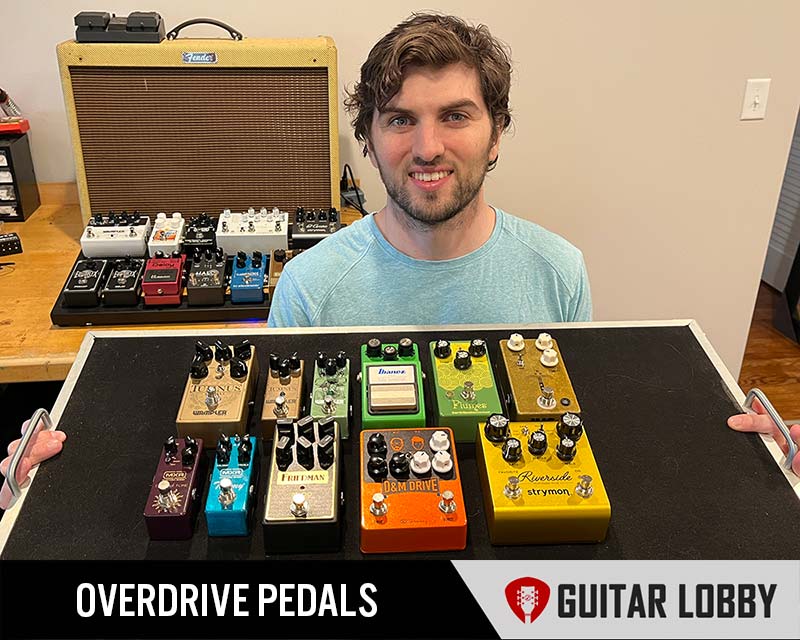
Purchasing new pedals can be a little overwhelming due to the sheer number of options available today. With new manufacturers seemingly popping up every week, you have to sift through the filler to get to the premium overdrive pedals that are worth buying. That’s why I’ve written this extensive guide, to outline the pros and cons of each option so you can make an informed decision.
I’ll start this article by reviewing the best overdrive pedals at each price point, but if you want to learn more about them before reading reviews, we have an in-depth buying guide at the bottom of the page explaining how overdrive works, what to look for in a pedal, and how to get the best out of your chosen one.
Here Are the Best Overdrive Pedals
1. Wampler Tumnus Deluxe (Editor’s Choice)
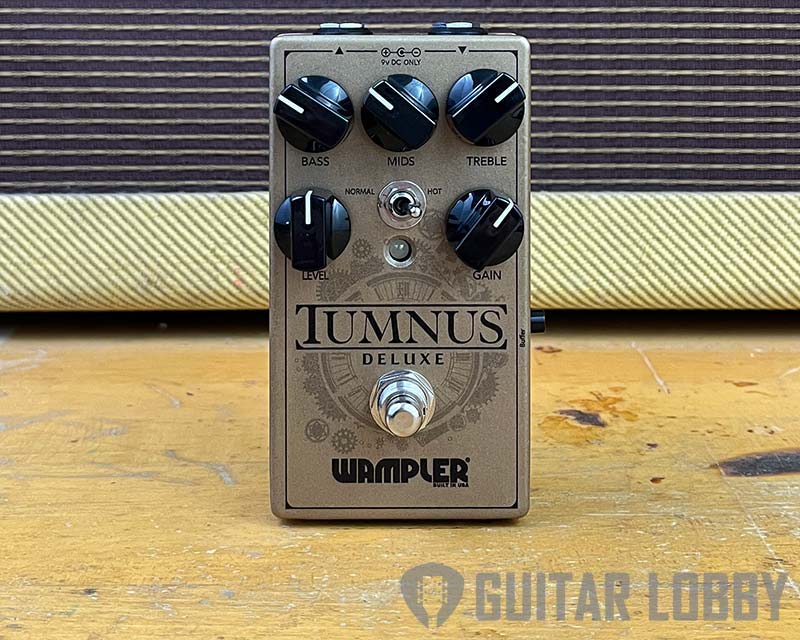
| Estimated Price | $200 |
| Type | Analog |
| Effects | Overdrive |
| Connectivity | 1 x 6.35mm Jack Input, 1 x Output |
| Power | 9 Volts DC |
My Review: I’ve grown very fond of Wampler effects pedals in recent years, as they’ve become one of the classiest pedal manufacturers in the USA. Their range of effects pedals is filled with unique and individual features, making them popular for guitarists and bassists across all genres. The Tumnus Deluxe happens to be one of my favorite overdrive pedals on the market and is undoubtedly one of the best Klon clone overdrive pedals money can buy.
This is a high-end overdrive pedal. With an articulate buffer, it produces immaculate clarity with plenty of distorted power. On the face of the pedal are five adjustable parameters. The top row acts like a 3-band EQ, with Bass, Mid, and Treble adjusters. I enjoyed the simplicity of using these controls and found that the knobs are ideal for removing problem frequencies which can tarnish the overdrive effect if not dealt with. I also commonly use the three-band EQ to make sure that the wet signal is consistent enough with the dry signal of your electric guitar – an essential practice for playing live or recording.
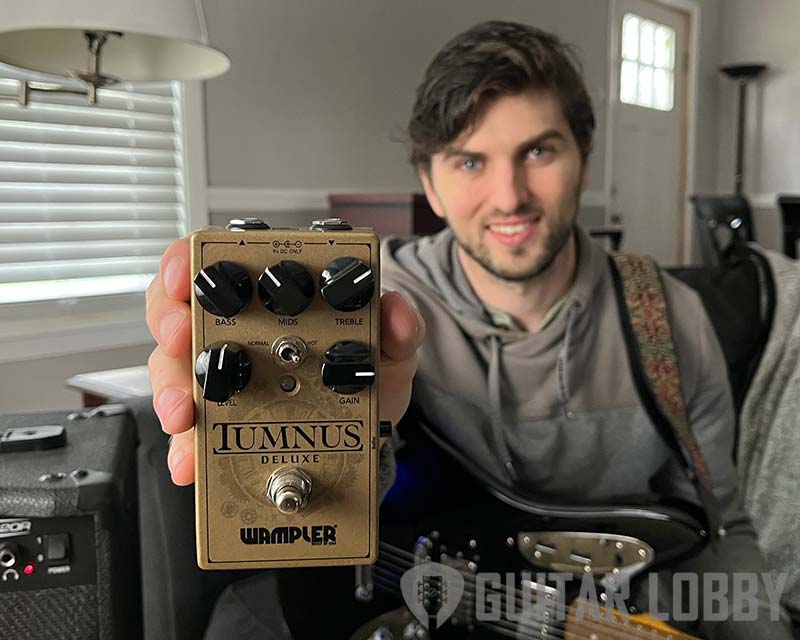
Along the bottom row of controls, we have Level and Gain. I like to adjust the level to keep the dynamics from being overpowering when the pedal is activated, but once you find the sweet spot, you probably won’t need to alter this parameter too often. Furthermore, I like to use the gain control to turn the pedal into a distorted monster when this suits my song. The built-in buffer actually boosts the gain of your clean signal if you choose to use it in Normal Mode rather than True Bypass. I can envisage guitarists who enjoy a little bit of unpredictability from their distortion-based pedals will enjoy using the Wampler Tumnus. It lends itself to all varieties of rock, blues, and metal or acts as a simple gain booster if set to Normal mode. The only criticism I had of the original Tumnus pedal was that it was susceptible to producing a slightly random break-up, but while experimenting with this new, improved version, I’ve found that it retains that quality but gives me the option of a more clean sound when you switch over to the True Bypass circuitry mode.
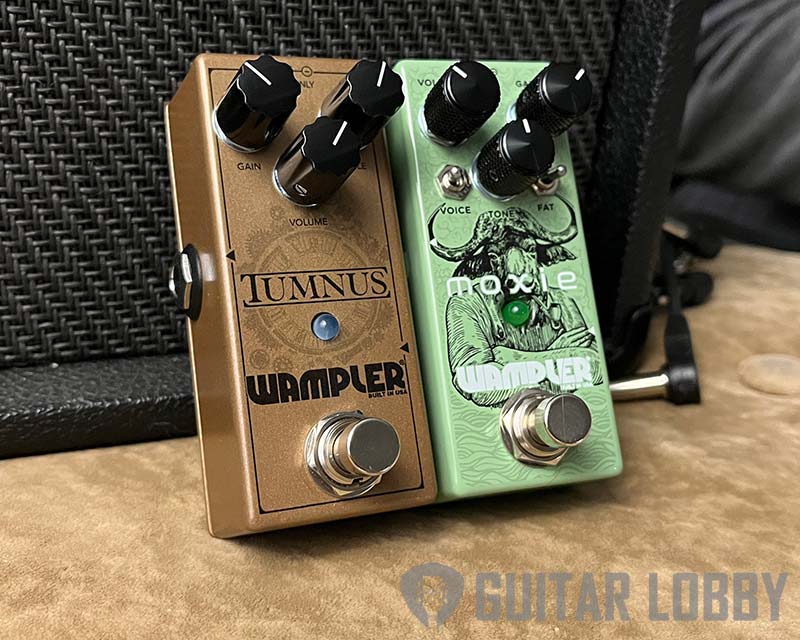
Wampler also produces a non-deluxe version of the Tumnus as well as the Moxie Overdrive, which is a Tube screamer clone. While each of these comes in a mini stompbox, they pack the same great tone, just a bit less control functionality. The Tumnus loses its 3-band EQ functionality from the deluxe model as it simplifies down to a single treble control.
Bottom Line: The Wampler Tumnus is a premium quality overdrive pedal that benefits from an articulate buffer. It gives you the option of True Bypass or the gritty preset of the original model. It’s not the cheapest overdrive on this list, but the old adage of paying for what you get definitely rings true here.
2. Ibanez TS9
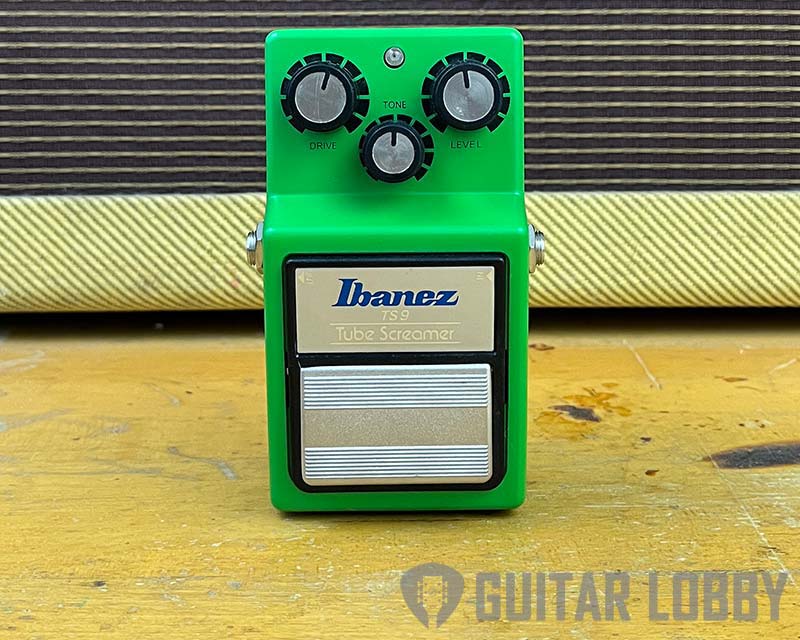
| Estimated Price | $110 |
| Type | Analog |
| Effects | Overdrive |
| Connectivity | 1 x 6.35mm Jack Input, 1 x Output |
| Power | 9 VDC, less than 100mA |
My Review: The Ibanez Tube Screamer has been imitated many times, but nothing comes close to the original. This reissue from the original manufacturer contains all of the best aspects of the original model, with some updates made to bring it into the modern era, and I was highly impressed by its quality.
The TS9 Tube Screamer looks identical to the original – even when I looked closely at the design, the finer details from the classic pedal are all present. Housed in a green stompbox with the classic TS9 aesthetics, it’s even made in the same factory and with the exact same parts as the legendary original! One of the things that instantly blew me away when using this pedal was its ability to push a tube amplifier into saturation effortlessly without obliterating the tone. Unlike some pedals that are designed similarly to the TS9, this pedal avoids the over-normalization of the guitar signal, which allowed me to retain complete control over my dynamics based on the velocity of my strumming.
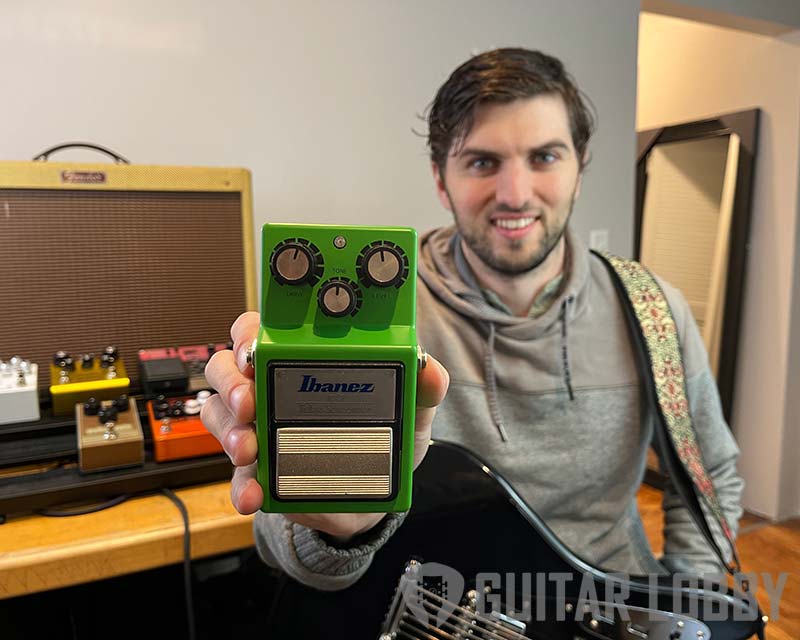
I also found that the simplistic design of this pedal makes it easy to get accustomed to using. I liked the fact that there are only three onboard controls – Drive, Tone, and Level. When altering the Tone control, I found it to be highly responsive and capable of manipulating the character of the overdrive to suit the style of music I was using it for. It provides you with a maximum gain of +30 dB, which was more than enough to overdrive the tubes in my amp, and I also found it convenient that the device can be powered by a 9-volt power supply or a singular 9-volt battery. Another thing that impressed me about the Ibanez TS9 Tube Screamer is that it is well suited to any genre of rock music – just like the original version. I like that it’s capable of both distortion and overdrive, so if you intend to purchase both pedals, this will save you the hassle, as you can easily adjust the three controls to create different varieties of gain-based effects.
The only issue I ran into when using this pedal was that the midrange could sometimes overwhelm the other frequency bands, but after tweaking the settings, I found that this could be easily resolved by simply lowering the Tone control to below halfway. Don’t get me wrong – I loved the midrange boost that this pedal provides for soloing or beefy rock riffs, but if you’re playing chords, it can cause the sound to get muddy if not dialed in a little.
Bottom Line: Ibanez’s pedals are known for their quality and simplicity, much like their range of instruments. At less than $100, the TS9 Tube screamer is great value for money. It gives you access to multiple overdriven and distorted tones without any unnecessary filler. Whether you’re looking for the best overdrive pedal for tube amps or solid-state amps, this is always a good option.
Popular Related Article: Our Favorite Guitar Amps (All Price Ranges)
3. JHS Morning Glory
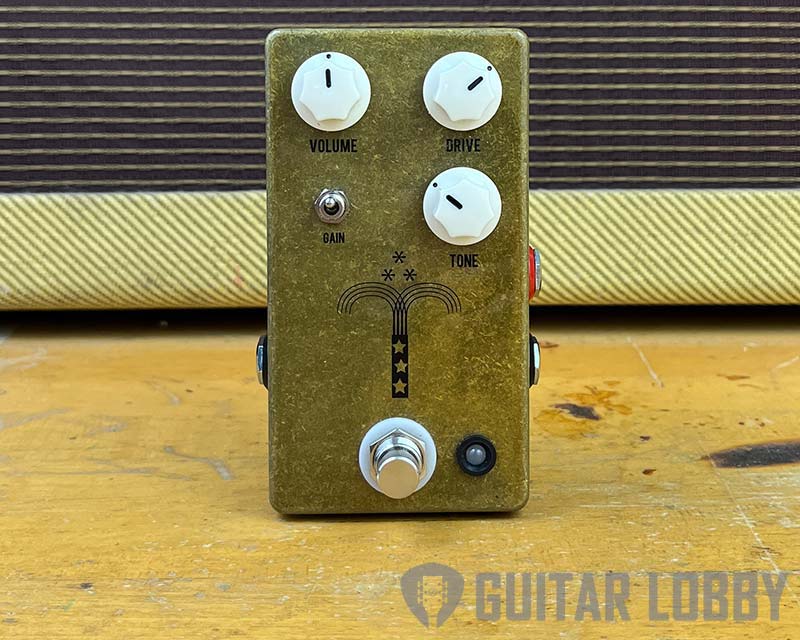
| Estimated Price | $200 |
| Type | Analog |
| Effects | Overdrive |
| Connectivity | 1 x 6.35mm Jack Input, 1 x Output |
| Power | 9 VDC, less than 100mA |
My Review: Since the first edition was released in 2009, the JHS Morning Glory has grown into a legendary overdrive pedal. This device has been a staple of my pedalboard since I first experienced the warm, authentic crunch that it injected into my tone several years ago – and I still find myself often amazed by its quality. At first glance, the Morning Glory may look like a simple stompbox with its Volume, Drive, and Tone controls, but the possibilities that these three rotary knobs offer are surprisingly vast. The tiny Gain switch is the finishing touch that makes this pedal one of my all-time favorite overdrive devices. When you switch this mode on, you get a classic, dirty blues overdrive that can make even the simplest of riffs or chord sequences sound amazing. When I find myself needing to cut through the mix when playing with my band, I like to flick the Gain switch and crank up the Drive control for a red-hot tone.
Another aspect of the JHS Morning Glory that I really enjoy is its ability to increase the sustain of my guitar, particularly when I’m bending notes and holding them during a solo. Setting the Drive and Tone controls at around 70% is ideal for elongating the notes you play without making them sound unnatural or overly processed. One of the things I always look out for when using overdrive pedals is whether it delivers tube-style saturation or whether it sounds too artificial, and the Morning Glory definitely falls into the preferable first category.
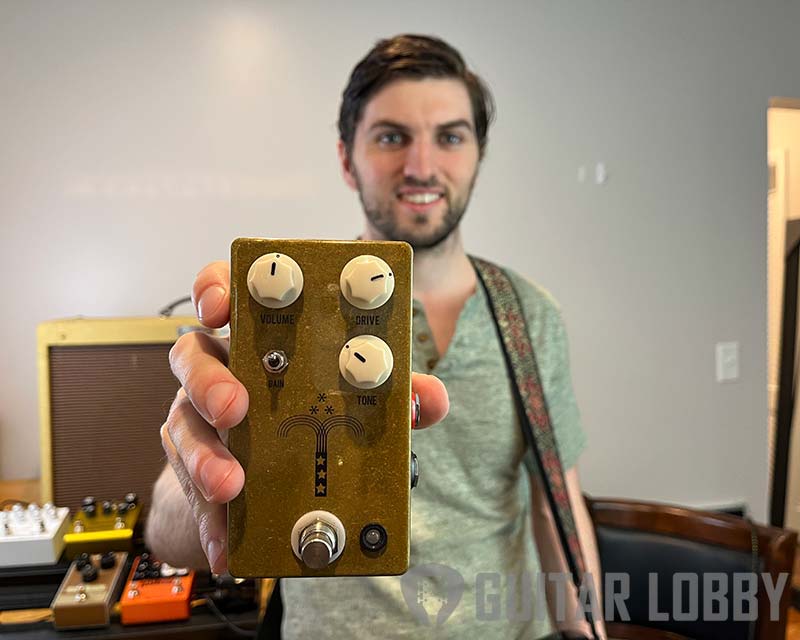
Compared to previous versions, the Morning Glory V4 boasts many improvements due to the slight design tweaks that JHS has made over the years. The most significant upgrade that I noticed is that the old design, which has a Bright-Cut switch at the front of the pedal, has been replaced by a more efficient Gain switch that is now located left of center, below the Volume knob. Although the previous toggle switch was useful for removing harsh high-end frequencies, I found the newly installed Gain switch to be much more impactful, particularly when you need to access a hotter tone instantly.
Before I’d even checked out the specs of the latest version of the Morning Glory, I noticed that its headroom had dramatically increased compared to the previous V3 model. It turns out that JHS has doubled the headroom of the pedal, and this really separates it from most overdrive stompboxes. I love that I can crank up the pedal and tube amp gain without worrying about signal clipping or distorting. When I dig into the strings with a pick, the Morning Glory can easily handle it!
Stylistically, I would recommend this pedal to anyone who plays rock guitar or any of its many subgenres. I particularly enjoyed playing some classic rock n’ roll chord sequences with this pedal on, as it provides just the right amount of crunch to make simple patterns more exciting. With the Gain switch on and the Drive control cranked up, I was really impressed by the tone that this device was able to draw out of my amp. It performed brilliantly for Stevie-Ray Vaughn-style blues licks and fast-paced solos. The only slight weakness I’ve noticed when using this pedal is that the Tone control must be used with caution – even pushing it a little too far will remove a lot of the low-end from your guitar as it acts as a pretty extreme high-pass filter.
I’ve also experimented with the Red Remote footswitch, which JHS recommends you use with the latest version of the Morning Glory. It took a little while to get used to using it to adjust the gain levels of the pedal, but I eventually found it to be a very useful tool when switching between lead and rhythm playing or styles that require significantly different amounts of gain.
Bottom Line: There’s a reason the JHS Morning Glory has been one of the world’s most popular overdrive pedals since 2009 – it delivers on its promises. Combining a simple control layout with a diverse range of saturated tones, this pedal is a must-have for guitarists who need heat on demand.
4. JHS 3 Series Screamer (Best Value)
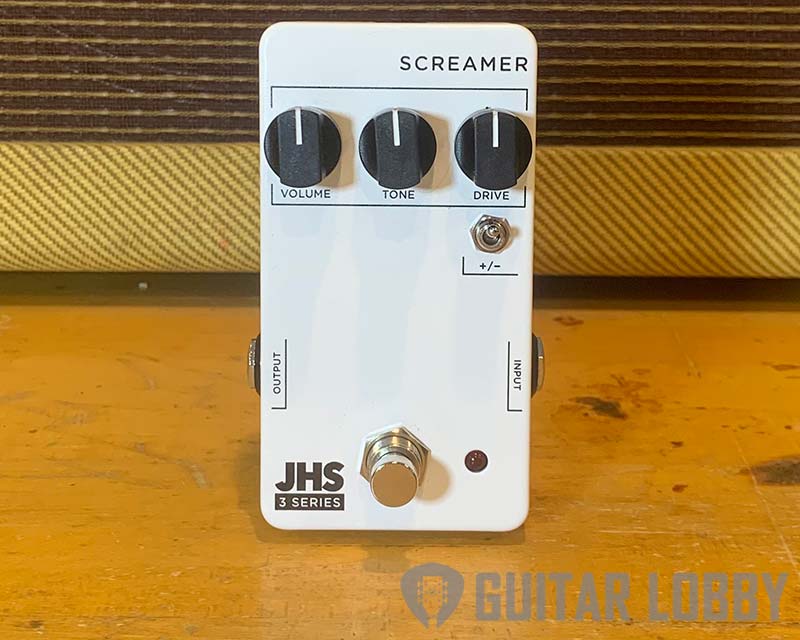
| Estimated Price | $99 |
| Type | Analog |
| Effects | Overdrive |
| Connectivity | 1 x 6.35mm Jack Input, 1 x Output |
| Power | 9 VDC, less than 100mA |
My Review: For a pedal that can be picked up for less than $100, I must say that I am amazed by the capabilities of the Series 3 Screamer by JHS. Despite its minimalistic control layout, I found this pedal highly versatile and offers plenty of room for adjustment. I’ve tested many Tube Screamer-style pedals over the years, but this stompbox adds something unique to one of the most popular overdrive circuits ever.
The first thing I noticed about this pedal was its ability to brighten up my electric guitar tone without making it too harsh. After playing around with the three onboard rotary controls, I stumbled upon something quite interesting; when I set Gain to around 9 o’clock and cranked the Volume control up high, the low-end became less prominent, and the saturated upper mids and treble frequencies became much clearer. The resulting tone is perfect for riffs or solos that need to transcend the muddiness of the bass, drums, and other instruments in a band.
Like the Morning Glory overdrive, the Series 3 Screamer has a small toggle switch. Labeled as “+/-,” this switch allows you to select two distinctive clipping types, essentially digital distortion. I was slightly skeptical about this feature before testing it, as I’m not usually a fan of intentional digital clipping and tend to sway more toward the organic tube-style overdrive that is produced by vintage amplifiers. However, to my surprise, I actually found this switch very useful. When I pushed it upwards, this triggered what is known as asymmetrical clipping, and when I pushed it down, it became symmetrical. The former variety sounded more unpredictable to me, while the latter had a smoother, tube-style sound to it.
Bottom Line: After testing this stompbox while playing a wide variety of genres, I can attest to its versatility. Whether you’re a classic rock guitarist looking for some good-old tube overdrive or you play in a jazz ensemble and need to add more color to your solos, the affordable Series 3 Screamer is a great choice.
5. MXR Timmy
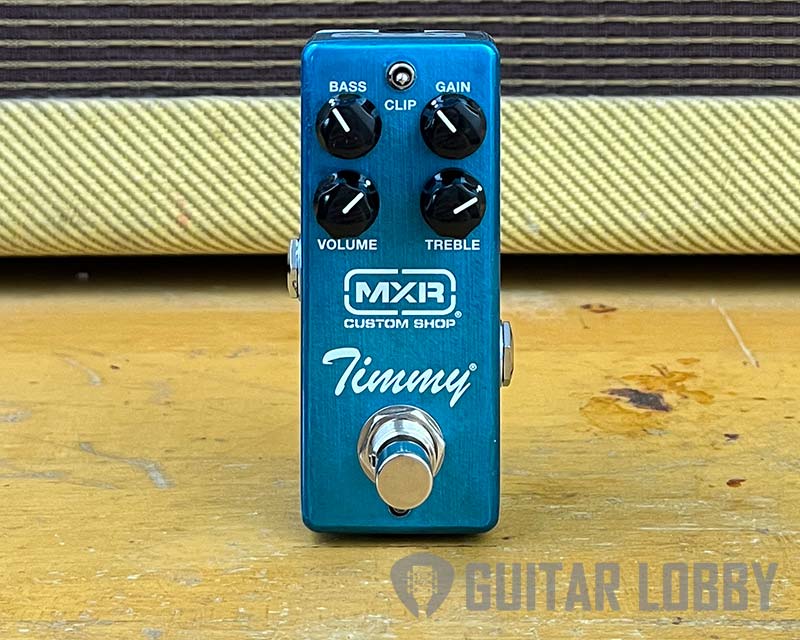
| Estimated Price | $150 |
| Type | Analog |
| Effects | Overdrive |
| Connectivity | 1 x 6.35mm Jack Input, 1 x Output |
| Power | 9 VDC, less than 100mA |
My Review: I’ve always been a fan of MXR pedals and have frequently used them as part of my various guitar effects rigs. One of the brand’s stompboxes that I’ve used for the longest is the compact and reliable Timmy Overdrive, which packs a considerable punch for such a small pedal. My slight obsession with guitar pedals has led me down many rabbit holes in the past, studying the most skilled brands and individuals in the effects designing industry for many years. I’d been using this pedal for quite some time before I learned about its backstory, which only added to its appeal. Designed by Paul Cochrane, the Timmy Overdrive quickly became highly sought after and eventually went out of production. Thankfully, MXR saw its potential and teamed up with Cochrane to make it widely available to guitarists like you and I.
If I had to sum up what I like the most about this classic overdrive stompbox, I’d go for its exceptional transparency. It avoids the trap of sacrificing tone natural tone produced by your guitar and amp and instead coats the signal in warm overdrive that isn’t at all overpowering. I also like how you can get some pretty extreme saturation out of the pedal if you activate the Clip switch and increase the Gain parameter to a high value. I did, however, find that the four rotary controls and the switch were quite cramped together, which could be annoying if you want to change the settings quickly during a song, but as long as you take the time to become familiar with the locations of the Bass, Gain, Volume and Treble knobs, this shouldn’t be too much of an issue.
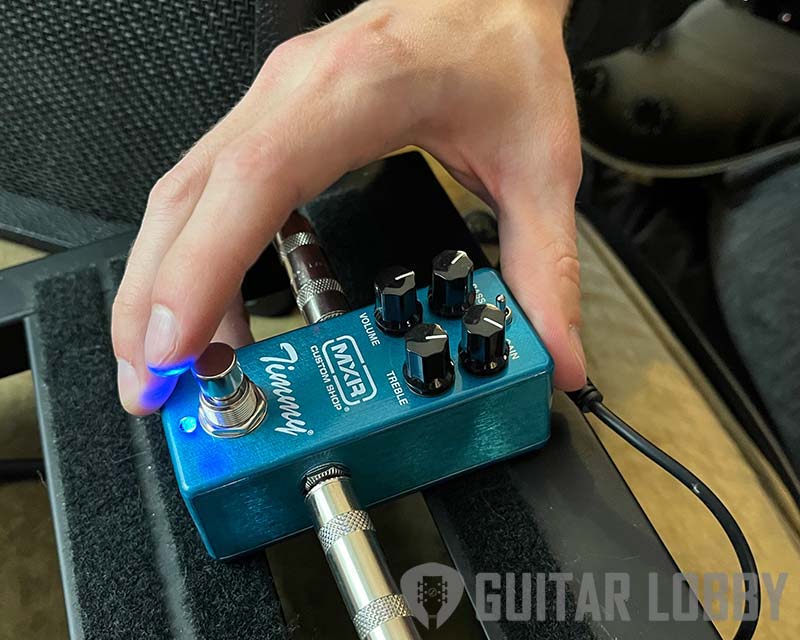
The Timmy also boasts several unique features that I’ve found useful when injecting more gain into my guitar signal. The two-band EQ consists of Treble and Bass controls, and the latter only affects the tone before saturation occurs. If I’m trying to keep my tone defined and sharp-sounding, this is a feature I’ll often use. The Treble control, conversely, offers the opposite effect – it alters the signal after the overdrive kicks in, and I’ve had success using this when I need to cut through the mix for a melody, riff, or flashy solo.
Bottom Line: There’s a reason that Paul Cochrane’s Timmy is one of the longest-standing and best-selling overdrive pedals in history – it does exactly what you need it to without any overcomplications. In addition to the excellent overdrive effect this pedal produces, it’s also affordable and very compact so that it won’t take up an unnecessary amount of room on your pedalboard.
6. Strymon Riverside
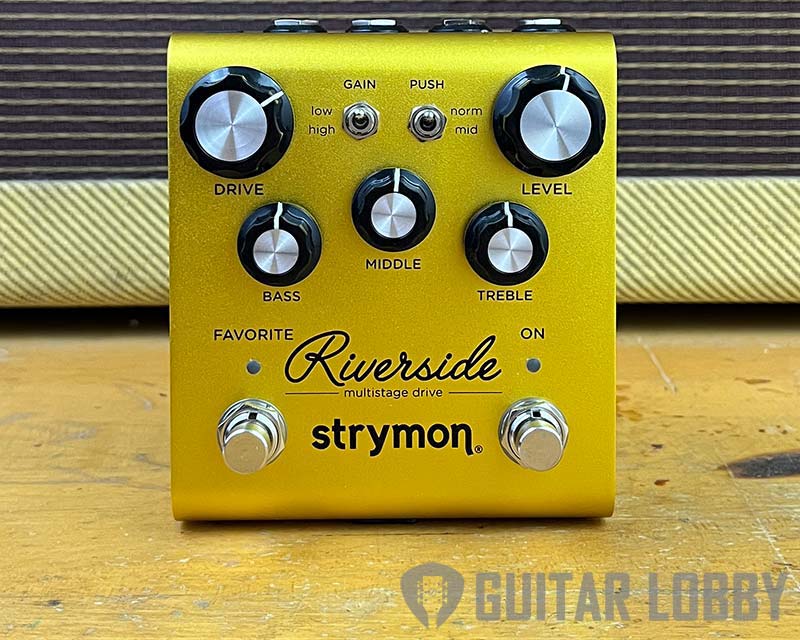
| Estimated Price | $300 |
| Type | Analog |
| Effects | Overdrive |
| Connectivity | 2 x 6.35mm Jack Input, 1 x Output, 1x Boost Output |
| Power | 9 VDC, minimum of 250mA |
My Review: The Strymon Riverside overdrive pedal is one of my all-time favorites, and I’ve used it for many of my electric guitar recordings in recent years. This boutique device provides a classic, authentic overdrive that wouldn’t sound out of place on a Rolling Stones recording from the late 1960s – it also offers a vast range of adjustable controls and sonic possibilities. When describing what I like most about this pedal, it’s difficult to know where to start, as there are so many great aspects. One of the features I find myself using the most is the combination of switches located at the top center of the pedal, one labeled Gain and the other Push. The Gain switch is pretty self-explanatory – I like to set it to high when I need to get plenty of drive out of my tube amp and low when I’m looking for a smoother tone, perhaps for playing rhythm guitar. The Push switch is essentially an EQ booster, which nudges the midrange frequencies up in volume, creating a chunky, thick tone that I like to use when playing chords.
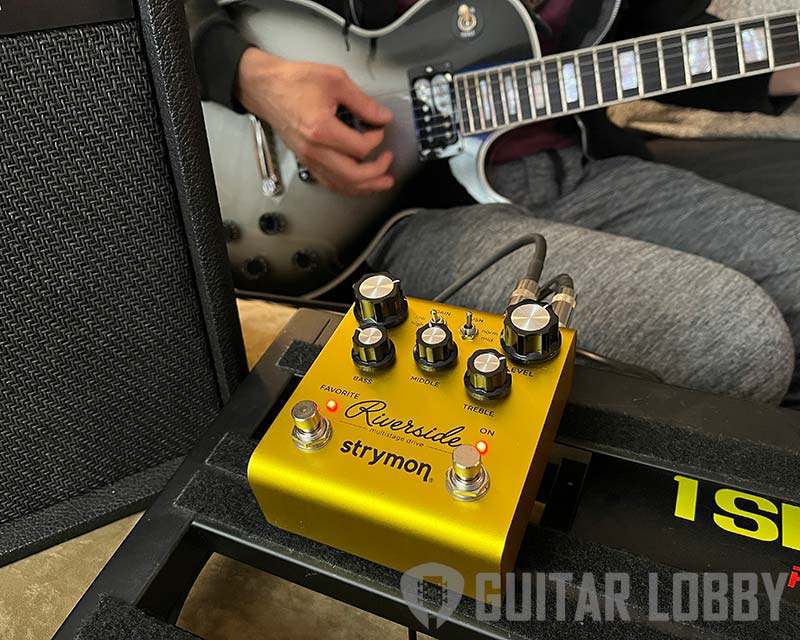
To get the best out of this pedal, I like to use it after some gentle compression in the chain. This helps tame any wild frequencies that can occur when you crank up the Drive control and set the Gain switch to high. But it’s unnecessary if you’re aiming for a rough, gritty tone. The other controls you’ll find on this pedal are labeled Bass, Middle, Treble, and Level, all of which control the tone and dynamic aspects. By adjusting the three-band EQ, you can create any overdriven tone you like, which is great if you play in various musical styles, as I do.
The Class A JFET input is, in my opinion, instrumental to the quality of this Strymon Riverside overdrive pedal. It behaves remarkably similar to a tube amplifier, breaking up at specific points and providing the slight unpredictability that a guitarist wants when aiming for a vintage saturated tone. I’ve also had a lot of fun experimenting with an expression pedal set to control the Drive parameter, which allowed me to shape the effect as required during a performance, hands-free.
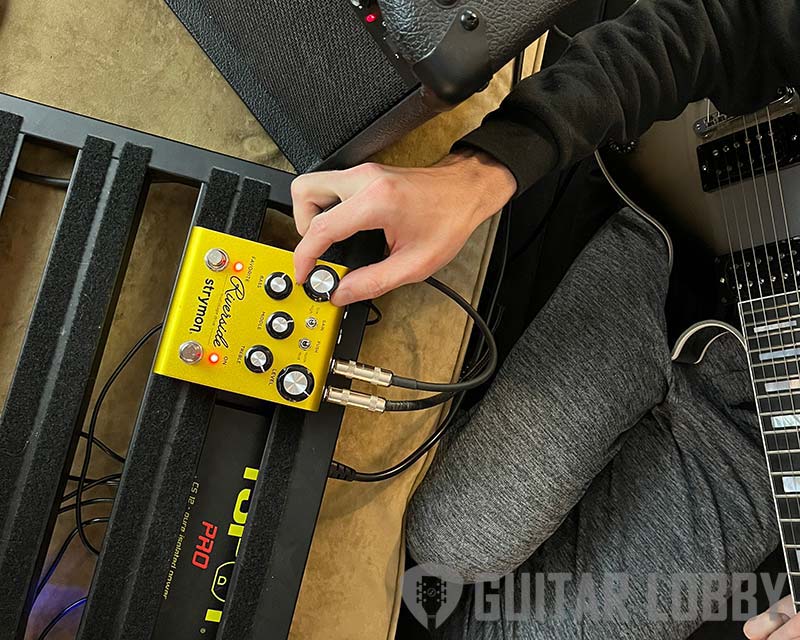
Bottom Line:If you’re looking for an overdrive pedal that puts you in complete control of the tonal and dynamic aspects of the effect, Strymon’s Riverside is an excellent choice. It’s built like a tank, has extensive connectivity options, and produces a high-quality range of overdriven tones that can be shaped to suit your preferences.
Popular Related Article: Our Favorite Looper Pedals at All Price Ranges
7. Keeley D&M Dual Drive (Best Drive + Boost Combo)
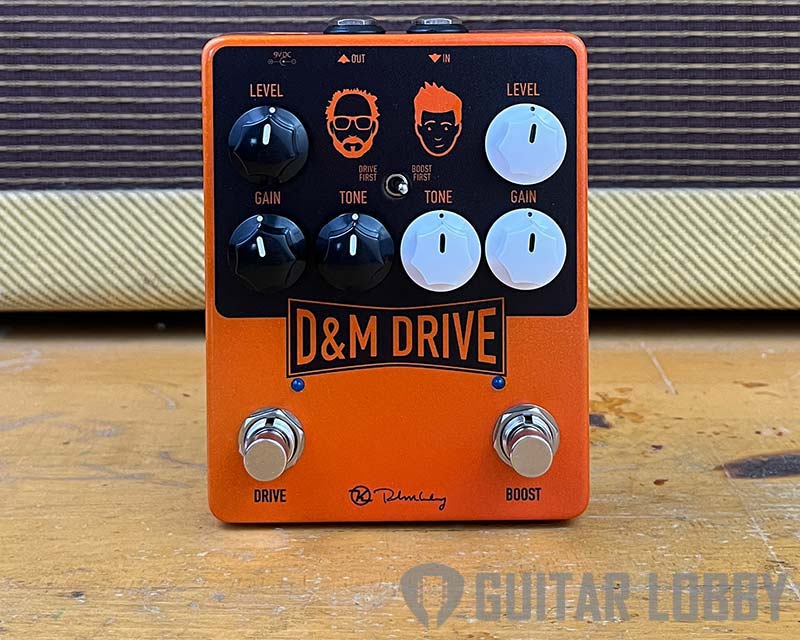
| Estimated Price | $230 |
| Type | Analog |
| Effects | Overdrive, Boost |
| Connectivity | 1 x 6.35mm Jack Input, 1 x Output |
| Power | 9 VDC, less than 100mA |
My Review: I’ve been an admirer of Robert Keeley’s pedal designs for a long time, and I always try to get my hands on any new devices that the Keeley brand manufactures. The D&M Dual Drive impressed me as soon as I plugged my electric guitar and strummed a chord with it turned on. It’s the type of pedal that I didn’t need to spend hours fiddling with the controls to get a great overdriven tone from – making it a good choice for those who like to plug in and play. The thing I found most interesting about the D&M Dual Drive is that it houses two pedals in one chassis – a classic, analog overdrive with a stackable boost ideal for elevating your guitar above the other instruments in a mix.
I was more interested in the overdrive section of this pedal when I initially got my hands on it, but as time passed, I began to realize that the real magic of this device lies in using the overdrive with the boost to complement one another. The pedal is designed flexibly so that you are able to decide whether the boost or the drive comes first. I personally prefer to use the boost first for most of my lead guitar playing, as this increases the volume of the overdriven tone without altering the frequency output too much. I’ve found that using the pedal the opposite way can be effective if you’re less concerned about consistency and would rather have more energy coming out of your amp’s speakers.
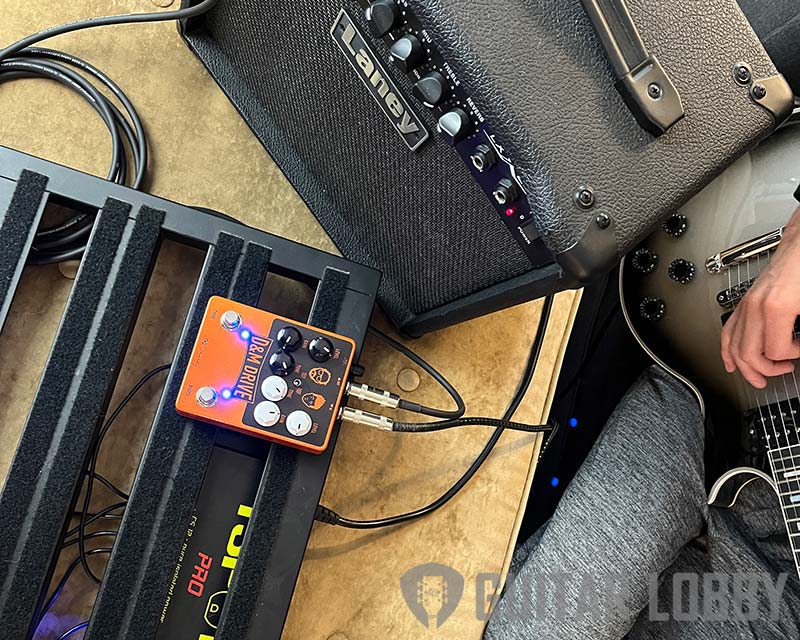
On the occasion where it is better to use only one of the effects that the D&M Drive houses, you can switch it to independent mode using the two footswitches located in the bottom corners of the pedal. I like that Keeley has considered the spacing of the controls – despite there being a total of nine switches and knobs included on the pedal, there’s enough room between the footswitches and the other controls to avoid accidentally adjusting them, which is an issue I’ve had with stompboxes in the past.
Bottom Line: If you’re considering purchasing a boost pedal along with overdrive, you can combine the two with this innovative pedal by Kelley. The D&M Drive allows you to choose between independent overdrive and boost effects or to blend the two to whatever degree you feel best suits the song you’re playing. The overdrive effect is warm, transparent, and can get dirty when enough gain is added to the signal. This is easily one of the best overdrive pedals ever made.
8. MXR Duke of Tone
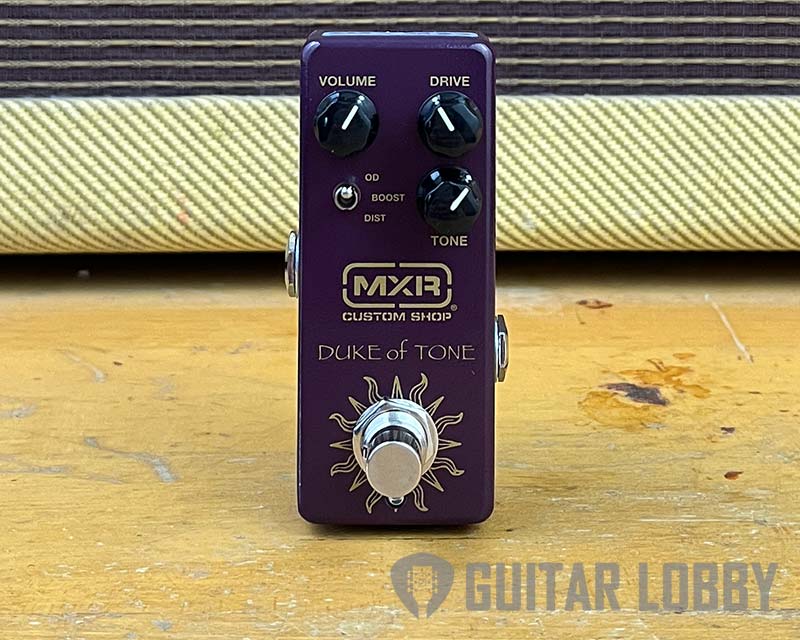
| Estimated Price | $150 |
| Type | Analog |
| Effects | Overdrive |
| Connectivity | 1 x 6.35mm Jack Input, 1 x Output |
| Power | 9 VDC, less than 100mA |
My Review: The MXR Duke of Tone is an affordable, compact pedal that, I must admit, took me by surprise. Looks can be deceiving when it comes to overdrive pedals, and I wasn’t expecting this device the provide the array of powerful tones that it did, mainly due to its small dimensions. The three-way toggle switch that is located under the Volume knob is so small that it’s easy to miss at first glance – but it’s the feature that I found most impressive and useful when playing with this pedal. When using my amp on a clean setting and switching to the OD mode, the pedal added the right amount of saturation without overpowering the natural sound of my guitar’s pickups and the amp. Then, when I switched to the default Boost preset, there was a slight increase in the overall volume of my signal. Finally, the Distortion setting is not for the faint-hearted – it instantly transformed my clean tone into a fireball of gain and drive!
The three knobs on the MXR Duke of Tone can then further shape the preset. I like to keep the Drive around 50%, then use the Tone control essentially as a high-pass filter, dialing it in when playing guitar parts that require a thicker tone and pushing it further when I’m trying to make my guitar more audible. The OD preset can be used both subtly and more prominently by altering the Drive and Tone knobs accordingly.
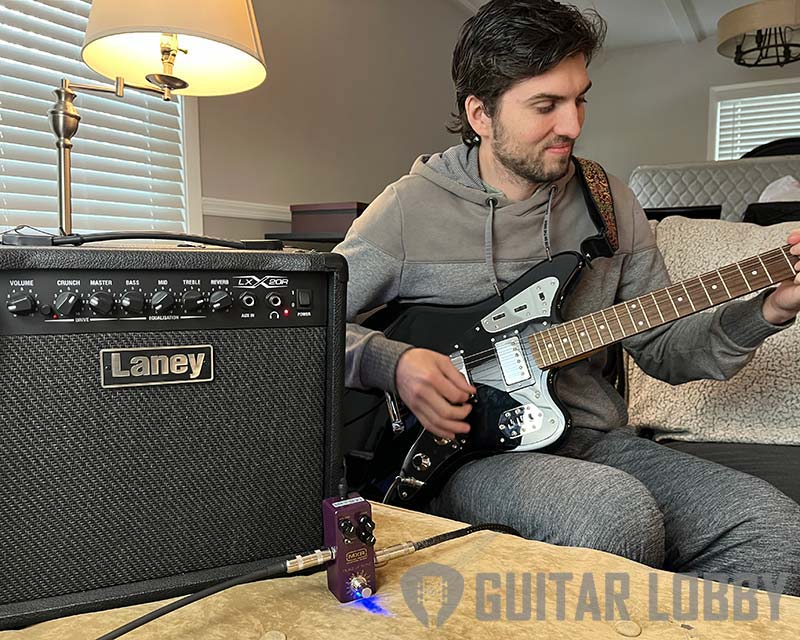
In terms of its physical design, this pedal is as solid as they come – which I’ve come to expect from MXR’s Custom Shop range. What it lacks in terms of size, it makes up for in terms of versatility, and you don’t need to be an expert in pedal controls to get a great sound out of this device. I also love the fact that MXR has designed the pedal so that it can be used either with a standard 9V power supply or with 18V, which increases the headroom and the overall performance, so I’d recommend using this to your advantage if your power supply setup will facilitate it.
Bottom Line: The MXR Duke of Tone meets the three main criteria of a great overdrive pedal. It produces high-quality overdrive effects, is very easy to customize using the onboard controls, and is built to withstand heavy usage. And to top it off – it’s very reasonably priced.
Popular Related Article: The 14 Best Guitars Made in America
9. EarthQuaker Devices Plumes
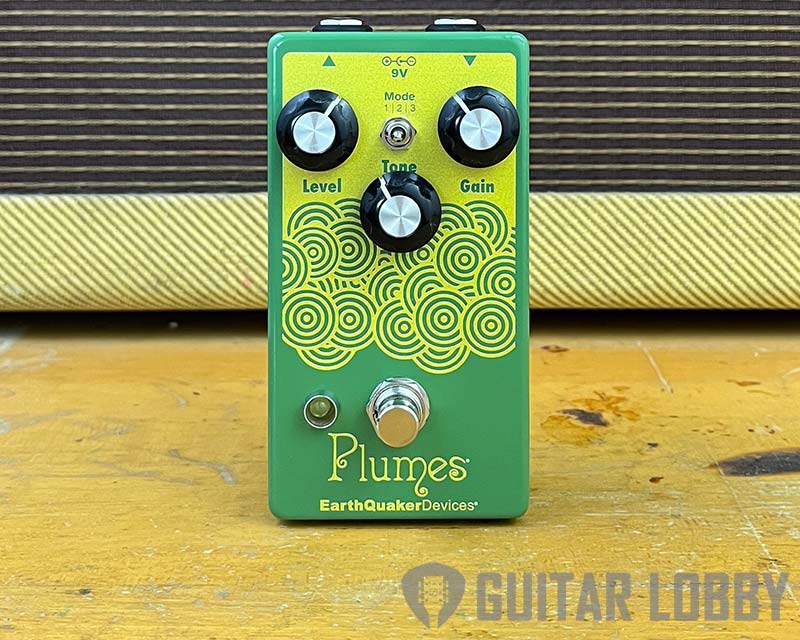
| Estimated Price | $99 |
| Type | Digital |
| Effects | Overdrive |
| Connectivity | 1 x 6.35mm Jack Input, 1 x Output |
| Power | 9 VDC, less than 100mA |
My Review: The Plumes by EarthQuaker Devices is a huge-sounding overdrive pedal that will grab an audience’s attention. It’s a hellishly loud pedal, but not loud in respect of unwanted noise. In my many years using them, I’ve found that a common issue with many distortion-based pedals is that the increase in gain and compression can cause them to be noisy, but not the Plumes – it maintains consistency even when pushed to ear-shattering levels, which has led to it being a staple in my heavy rock and blues effects chain.
In their description of the pedal, EarthQuaker Devices said that the Plume was very “deliberate sounding.” I’d definitely agree with that statement. Although it sounds gigantic, you can still hear all of the slight nuances of your playing, and the character of your guitar still shines through despite the power. I particularly enjoyed the way it preserves the detail of my playing when I’m combining melody and chords – even the more intricate techniques can be heard amongst the saturation, which is pretty rare for this type of pedal.
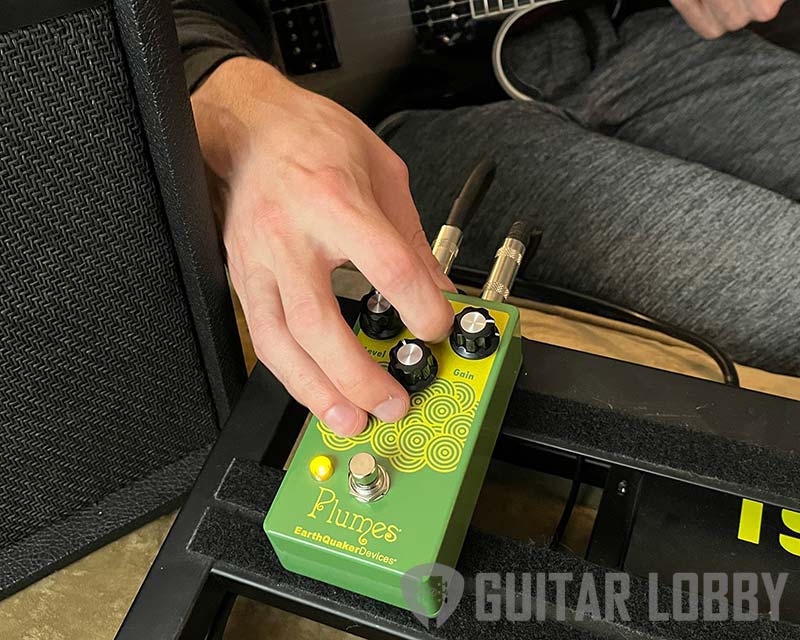
After analyzing its build quality and design, I can safely say that the components that were chosen by EarthQuaker Devices when constructing the Plumes pedal are of the highest order. As any great overdrive pedal should, the Plumes provides a sonic quality that is both unique and sounds familiar to me simultaneously. If you don’t want your guitar to sound too overdriven, the pedals can be toned down using the various controls to promote its hi-fi tonality. From my experience using this device, the Plumes pedal is a good option if you love high-gain guitar tones. It’s not overly expensive and is straightforward to use. I’d recommend this pedal for lead guitarists who need a big boost when the time to shred comes around.
Bottom Line: The EarthQuaker Devices Plumes pedal combines harsh gain with warm overdrive to create a versatile pedal. The inner circuitry was specifically chosen to push the gain to its limits whilst keeping any unwanted noise at bay. For around $100, it’s great value for money.
10. Friedman Amplification BE-OD
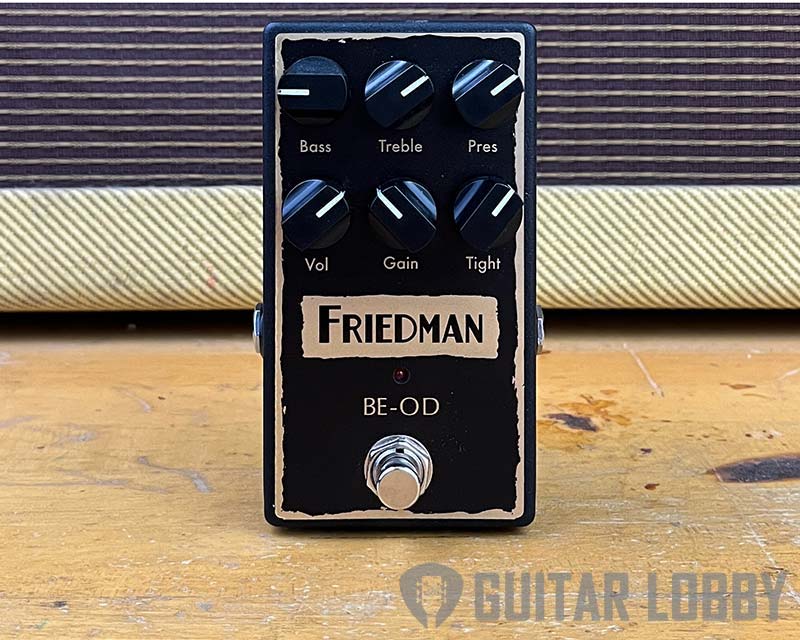
| Estimated Price | $200 |
| Type | Digital |
| Effects | Overdrive |
| Connectivity | 1 x 6.35mm Jack Input, 2 x Output |
| Power | 9 VDC, less than 100mA |
My Review: The BE-OD pedal by Friedman Amplification encapsulates the tone found in the legendary BE-100 amplifier, which has been used by world-class guitarists across multiple genres. When I first heard about this pedal, I couldn’t wait to see if the hype was real. I ended up liking it so much that it’s become my go-to overdrive when recording solos. The aspect I’ve found most appealing about this tube-amp style overdrive is that it has all the necessary controls for creating unique rock n’ roll tonality.
Firstly, this pedal strikes the perfect balance between the number of controls it offers and keeping things simple. The control layout consists of Volume, Gain, Tight, Bass, Treble, and Presence. The Volume control allows you to adjust the overall output when the pedal is turned on, the Gain affects the amount of distortion occurring when you play, the Tight control dials in some of the excess noise and compresses your signal, the Bass and Treble controls act as a 2-band EQ, and finally, the Presence knob affects the prominence of the overdrive within the mix.
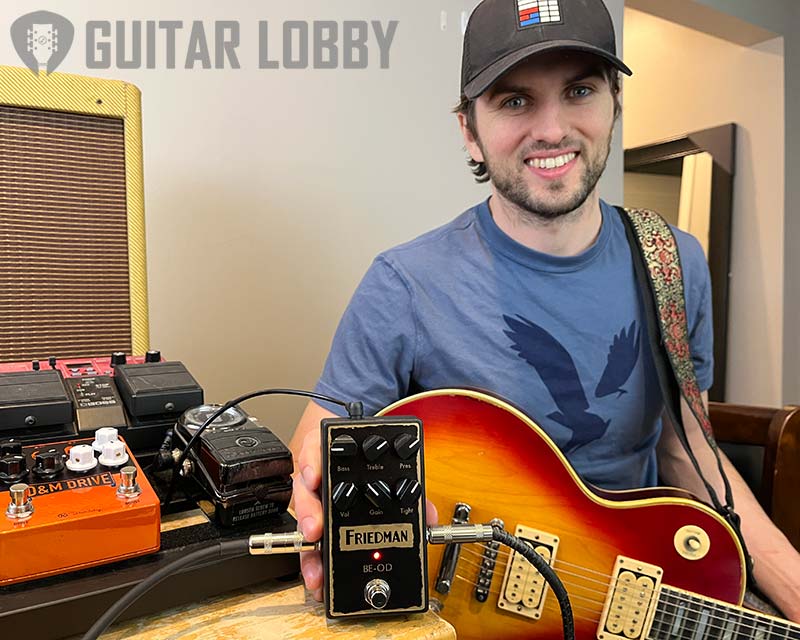
I’ll admit that prior to using this pedal, I was slightly skeptical over whether the Friedman could authentically recreate the iconic sound of the BE-100 in a stompbox format, but all credit to their team, which has impressively managed to capture its essence in this detailed pedal. Its design is classy and understated, and upon first feeling it, I could tell that it is constructed from durable metal housing to ensure its longevity. Whether you want to play lead lines at breaking point or add a touch of character to your guitar, this is the pedal. A versatile pedal, the BE-OD, is one I would recommend to guitarists across all genres. There are so many adjustable parameters on this pedal that you can tailor it to suit the exact style of your guitar playing.
Bottom Line: The BE-OD by Friedman Amplification is a brilliant recreation of their iconic BE-100 amp, and it features almost as many sound-adjusting qualities. For such a concise and compact pedal, it’s amazing how many parameters the manufacturer has managed to squeeze onto this pedal. Although it’s one of the more expensive options on this list, for such a high-quality overdrive pedal it’s well worth the cost.
Choosing the Right Overdrive Pedal (Buying Guide)
There’s no doubt that overdrive pedals open up a whole new world of sonic possibilities to a guitarist. Although many musicians know what overdrive sounds like, an understanding of how and why the effect is used is less common. Overdrive often gets categorized as being the same as distortion and fuzz, but in reality, the differences are important.
Even within the realms of overdrive, there are many variations and different tones that can be produced. In some instances, the effect is used sparingly to add a touch of coloration to a guitar, bass, vocal track, or another instrument. Alternatively, when overdrive is used for dramatic effect, it can transform your original tone into an unrecognizable fireball of thick distortion.
In the remainder of this article, I’ll look at overdrive pedals in-depth, providing you with all of the information you need on the subject. Whether you’re only interested in pedals or you want to learn more about overdrive from a production and mixing standpoint, I’ll cover it all in this extensive post.
What is Overdrive?
Understanding the way that effects are produced makes it easier to create your desired tones. Indeed, it’s possible to stumble across unique sounds purely through blind experimentation, but it’s unlikely that you’ll remember how to reproduce them in the future. Essentially, understanding effects and processing is a never-ending journey that reveals itself to you one step at a time, and with every piece of knowledge you attain on the subject, it becomes easier and quicker to translate the tones that you hear in your head into reality through your instrument.
So what is overdrive, and why is it so popular among guitarists? Technically speaking, overdrive is a variation of distortion. Although when discussing pedals specifically, it’s common that distortion and overdrive are used to refer to two quite distinct sounds.
So it’s fair to say that if we are to understand overdrive, we must first understand distortion. Distortion is an umbrella term that refers to the process when there is a deviation between two points of a signal path, within a sound wave. In many cases, distortion occurs unintentionally. When the gain of a waveform is too high, clipping occurs. Clipping is where the audio has to be compressed because it’s too loud. You’ve probably experienced this when standing too close to a microphone when recording, then when you look at the waveform its peaks and troughs aren’t visible, and instead, you can see a thick fuzzy block of audio.
Overdrive is a variation of the process I’ve just described. It’s fair to say that overdrive is a more subtle form of distortion, where the original tone is pushed harder to create a “break up”. When discussing pedals, overdrive is less dramatic than distortion or fuzz.
When overdrive is applied, you can still control the dynamic range of your instrument, whereas when distortion of fuzz is applied, the same amount of the effect is present no matter how hard or soft you play. Put more simply, overdrive pedals recreate your tone, whereas distortion or fuzz obliterates it! The more subtle nature of overdrive compared to other variations of distortion make it a popular choice for guitarists, especially if they want to keep some consistency between their clean tone and their wet signal.
How is Overdrive Produced?
Overdrive is produced when a certain amount of saturation occurs to the original sound signal. This can sometimes happen unintentionally, and unwanted forms of distortion can be a frustrating issue for musicians and audio engineers. For example, if you’ve recorded a guitar, vocal, or drum take with the gain set too high on the channel, you might find that the audio has clipped a little, causing it to saturate. The issue with this is that the audio is then difficult to mix because there’s no headroom.
When overdrive is produced intentionally, it can transform the feel and tone of a sound source. One of the most sought-after sounds for a guitarist is the subtle “break up” that is naturally produced by the valves in a tube amp. When the amp is pushed to its upper limits, the tubes are forced to work harder, and therefore overdrive is produced.
Overdrive pedals make the effect more accessible to guitarists without the need for vintage gear or expensive tube amplifiers. These pedals utilize digital technology to recreate the overdriven effect, by causing the circuit to overload and therefore giving a guitar a crunchy undertone.
Unlike a distortion or fuzz pedal, overdrive produces what is known as “controlled clipping.” The result is a more malleable effect, which responds to the velocity and style of playing rather than just causing the signal to distort in one consistent manner.
Overdrive and Saturation
The term saturation commonly pops up when searching for overdrive and distortion pedals. Like overdrive, saturation is a form of distortion, technically speaking. Saturation is used for multiple purposes in music, whether on vocals, guitars, or as part of the mastering process. It’s often found in garage or lo-fi rock recordings of the early ’00s.
Saturation was first used as an effect back in the days of analog recording studios. Recording engineers during this period would monitor the signal level to check that it wasn’t clipping and remained within the safe window of dynamics. If the recordings were too quiet, hiss would be noticeable from the tape reels, whereas if it was too loud, it would result in saturation.
When the input signal reaches a high level, a point is reached where the tape can’t record any more signal. This type of vintage saturation is quite random and hard to manipulate, hence the invention of digitally occurring overdrive, distortion, and fuzz pedals. The benefit of using digital technology to produce overdrive and similar effects is that the compression occurs suddenly as a result of the pedal being activated, causing an abrupt spike in the waveform, therefore altering the sound of the original sound source.
Overdrive vs. Distortion vs. Fuzz The Differences
As is the case with most audio processing effects, there are many variations that are labeled under the same term. In the case of overdrive, there are two other varieties that fall under the same category and are usually grouped together – distortion and fuzz. In this sense, I am referring to distortion not as the umbrella term that I described earlier but as a standalone effect. It would be correct to say that overdrive and fuzz are simply different forms of distortion when speaking from a purely technical standpoint, but when discussing effects pedals, the three are seen as separate effects with distinct differences.
Overdrive pedals are perfect for producing natural amounts of saturation, replicating the warm sound of valves “breaking up” in a tube amplifier. Although nothing quite comes close to the authentic sound of this occurrence, the advances in music technology over previous decades have produced some pretty realistic representations. The most prominent difference between overdrive and its two sibling effects is that overdrive reacts to the human elements of your playing in a similar fashion to a tube amp. The clipping that occurs isn’t too extreme, so the dynamic range is still within your control. Overdrive pedals add a warm, smooth layer to your clean tone without obliterating it.
Distortion pedals work in a similar way to overdrive pedals but in a more extreme manner. Commonly used in heavier styles of rock music, these pedals cause the signal to clip significantly, thickening the body of the waveform and therefore producing a screaming tone. Distortion pedals are available with both digital and analog circuitry. If you want to recreate tube distortion, there are pedals that actually contain vacuum tubes within their internal mechanisms.
Much like distortion but with even more bite, fuzz pedals take the original signal and cause it to clip at a much more aggressive rate. This results in a square wave being produced. If you imagine the shape of a square, this indicates the sharp peaks where the corners are at 90-degree angles. These peaks cause the signal to be saturated heavily, causing the resultant tone to be pretty much unrecognizable in comparison to the clean tone. Fuzz is commonly used for heavy rock riffs, blues guitar solos, or as a way to add coloration to a bass guitar.
Overdrive vs. Distortion vs. Fuzz Summary
Hopefully, now you’ve grasped the basic concepts of overdrive, distortion, and fuzz. These three effects are extremely effective tools to have in your arsenal. Which one’s you should implement onto your pedalboard really depends on the style of music you play, the style of your individual guitar playing e.g. lead or rhythm, and the other effects that you may intend to combine overdrive, distortion of fuzz pedals with. Here’s a brief summary of the main characteristics of the trio
Overdrive Pedals:
- Occurs when the tubes of an amplifier are pushed to breaking point
- Responds to the dynamics and velocity of your playing
- Adds a warm layer to the dry signal
- Causes small amounts of clipping in the audio waveform
Distortion Pedals:
- First occurred with tape distortion in analog recording studios
- Harsher than overdrive
- The signal becomes consistent and doesn’t react to playing velocity
Fuzz Pedals:
- Obliterate the original sound
- Cause the audio to hard-clip
- Creates a square waveform
- Unresponsive to the dynamics of the instrument
Controls and Parameters that Commonly Feature on Overdrive Pedals
In your search for an overdrive pedal to add to your setup, you’ve probably come across some staple controls that commonly feature. There’s some variation from pedal to pedal, but generally, the following combination will form the basis of most OD pedals.
- Level/Volume
- Tone
- Drive
- Filter
The Level/Volume control is featured on all overdrive pedals, and its function is pretty self-explanatory. Think of it as a wet/dry control, which adjusts the amount of overdrive that is present. The volume control is important when dealing with forms of distortion or overdrive because sometimes the overdriven signal can be significantly louder than the dry signal, so you can anticipate that and tweak the level accordingly. This stops dynamic spikes from occurring on stage.
The tone control affects the coloration of the overdrive effect. It causes the pedal to make certain frequencies more prominent and makes the sound thicker or thinner. In this respect, it’s very similar to the tone knob on an electric guitar.
The drive control on an overdrive pedal cranks up the gain of the effect. This parameter affects the amount of distortion present, so if you were to turn it all the way up you’d get more clipping and saturation, whereas with it turned down, the effect will be less dramatic.
Filter controls aren’t featured on all overdrive pedals, but you’ll find them on the more expensive, detailed models. Similar to a tone knob, filters affect the frequencies produced by the pedal. This is a useful tool for removing harsh, unwanted frequencies from your guitar’s output or creating contrast.
Combining Overdrive with Other Effects
Due to the subtle nature of overdrive, it’s highly compatible with a range of other effects. There are so many options when it comes to combining pedals, but it’s important to consider where you’re positioning them in your signal chain, a topic I’ll cover in detail later in the article.
More extreme versions of distortion, like fuzz, can be difficult to mix with other effects without the sound becoming harsh and over-the-top. Of course, there’s a place for that kind of extreme tone, but if you want to experiment with combinations of different effects pedals, overdrive is an easy option in this respect.
One of my personal favorite FX combos is “space” and “dirt.” Space refers to timing-based effects like reverbs or delays and dirt is any form of distortion. Adding some reverb to an overdriven guitar can sound incredible. There’s something elusive and alluring about the warm, breaking tone with some light, dreamy reverb sprinkled on the top. The contrast between soft and hard really adds color to your guitar’s sound without making it overly muddy,
Of course, it would be wrong to conclude this section without mentioning the magic combination of overdrive and wah-wah. Popularized by none other than Jimi Hendrix and later re-ignited by the likes of John Frusciante and Tom Morello, this mixture turns the guitar into an out-of-this-world instrument that is brimming with character and sounds so pleasing to the ear.
Where an Overdrive Pedal Should be Positioned in Your Signal Chain
It’s important to do your own “research” when it comes to positioning pedals in the signal path. Ultimately, it comes down to your own personal preference. The only way to figure out which orders you like the sound of is to dive in and start experimenting.
With that being said, there are some generally accepted advisories that most guitarists follow. If you’ve got no interest in being like “most guitarists,” feel free to skip this brief section! I’d recommend learning the reasons why certain combinations work, though, so I’ll explain that now.
Usually, it’s accepted that a “dirt” pedal, like distortion, overdrive, or fuzz should be placed just after any dynamic pedals, like compressors, toward the start of your signal chain. The main reason for this is that if you were to place an overdrive, distortion, or fuzz pedal toward the end of the chain, every single pedal that comes before it will inevitably be affected by its presence. For example, if you had a stacked pedalboard with numerous reverbs, delays, chorus, and filter pedals, then positioned you to overdrive pedal after them, the result would be that all of the aforementioned pedals are affected by the overdrive, creating pure chaos.
Don’t get me wrong, in some cases, chaos can be a good thing. But it’s better to have the option of keeping your signal nice and clean, then using the pedals for maximum effect, and that’s why most guitarists would place dirt as close to the start of the signal chain as possible after dynamic-based pedals.
Overdrive on Vocals
Using distortion-based effects on vocals is a tricky undertaking, but it can sound brilliant if done correctly. The issue with using guitar pedals to process vocals is that they often cause feedback issues due to the clipping that they provoke.
One way around this is to use an overdrive pedal in conjunction with a feedback suppressor. This will limit the background noise produced by the effect, and make it sound cleaner on vocals. If you’re looking for that garage rock, rough n’ ready tone that sounds like a microphone running into an amplifier that’s had a hole kicked in, then using an overdrive pedal could be the perfect solution.
Overdrive Pedals and Signal Splitting
Signal splitting is a useful process to learn about, as it applies not only to pedals and amplifiers but mixers and other recording studio equipment too. So what is signal splitting? Basically, it’s where you send a dry and wet output from the same sound source into a pair of inputs, creating two signals from one source.
In the case of overdrive pedals, you might have noticed that some of the options I previously presented in this list were fitted with two outputs. This makes it possible to split the signal and send the wet/dry into separate amplifiers.
The reason that guitarists and bassists use this trick is mainly to give them a thicker, more full-bodied sound. When using a dual-amp setup, your clean tone is constantly playing, even when you turn on an effects pedal. So the dry signal forms the foundation of your tone, then when an effect is turned on the wet signal is sent to a separate amp. This gives the illusion that two guitars are playing the same thing with differing tones.
Splitting the signal is a great way to compensate for the lack of a second guitar in your band, or if you play the bass, you can use your effects channel as a replacement for a guitarist while maintaining the fullness of your low-end frequencies.
Using Overdrive in the Recording Studio
The great thing about purchasing effects pedals is that they’re not only a useful addition to your live setup but can be a great asset in the recording studio too. When recording with pedals, you have two choices. Firstly, you can run them into your amplifier to recreate a similar tone to when you play live shows. Alternatively, you can run them straight into a direct input on your audio interface and process them retrospectively.
Overdrive is a versatile effect, so using it in both of these manners would produce good results. The advantage of recording straight into your interface is that there’s no coloration of your tone caused by the capabilities and attributes of your chosen amplifier.
Recording with pedals can get messy if you don’t set the gain and tone controls accordingly before starting. A good way around this is to record your guitar with no effects, straight into the D.I, and then analyze the waveform. If it is small and there’s plenty of excess room, your pedal can be set to a high level/gain before recording. If the signal is already large and leaves little headroom, you may need to turn down the input or tweak the parameters on your overdrive pedal.
When recording overdrive pedals through an amp, you need to bear in mind that the microphone you choose will also have a significant impact on the overall tone. If you’re using a dynamic mic such as the Shure SM57, it will be able to handle much more gain and volume, but the tone will be less bright than a condenser alternative. Again, experimentation is the best way to learn and discover the ways to create your desired tone.
Overdrive Pedals for Bass Guitar
Most of the overdrive pedals listed earlier in this article are compatible with both electric guitar and bass guitar. There are some which are specifically designed for bass, focusing the overdrive on lower frequencies that are more prominent on that instrument.
If you do decide to use your overdrive pedal on a bass guitar, there are a few things worth taking into consideration. The frequency response of a bass differs from that of a 6-string, so using the onboard tone controls to highlight the warmth of a bass guitar is a good idea.
Combining the overdrive pedal with an EQ pedal will also help to tailor it to bass. The “sweet spot” of a bass guitar usually resides around 200Hz-800Hz, so you can boost these frequencies slightly to emphasize the warm tones of the instrument.
Finally, as I mentioned previously, using a dual-amp setup is the perfect way to add an effects pedal to your bass guitar. This allows your dry signal to continue underneath the wet signal, making the overall sound thicker and preventing it from losing power when you activate a pedal.
Power Requirements
Almost all of the aforementioned pedals run off 9-volt power. You can choose whether to purchase the suggested power supplies that each model’s manufacturer recommends but to be honest, they all do the same thing. There are plenty of affordable power supplies online that will suffice.
There’s also the possibility to power an overdrive pedal using 9-volt batteries. The risk is that they may cut out mid-show, so I would recommend having a power supply but keeping fresh batteries in the pedal at all times. This way, if either the battery or the power supply cuts out, the other will take over, and you won’t have a dreaded cut-out on stage!
Conclusion
Overdrive pedals are one of the best additions you can make to your pedalboard. The subtle warmth that they add to your tone can completely transform your solos, riffs, and rhythm playing. It’s also a lot of fun experimenting with the various parameters that feature on these pedals.
Hopefully, after reading through this comprehensive guide, you’ve got a good grasp on their functions and what to look for when purchasing. All that’s left to do now is create some unique tones with your new addition!

My name is Chris and I’ve had a passion for music and guitars for as long as I can remember. I started this website with some of my friends who are musicians, music teachers, gear heads, and music enthusiasts so we could provide high-quality guitar and music-related content.
I’ve been playing guitar since I was 13 years old and am an avid collector. Amps, pedals, guitars, bass, drums, microphones, studio, and recording gear, I love it all.
I was born and raised in Western Pennsylvania. My background is in Electrical Engineering, earning a Bachelor’s degree from Youngstown State University. With my engineering experience, I’ve developed as a designer of guitar amplifiers and effects. A true passion of mine, I’ve designed, built, and repaired a wide range of guitar amps and electronics. Here at the Guitar Lobby, our aim is to share our passion for Music and gear with the rest of the music community.

Hey Christopher, I just wanna say “Nice Job!” I stumbled onto your channel verifying the Gibson CE guitar that Chet Atkins used. I have thus far only watched the video concerning the Gretsch 6161 amp. Even though I am at the bottom of the the layman pile, I know good info when I’m exposed to it.
Thank you for your hard work.
Jim Burrell
P.S. – Please, no need to respond. I hope you will use your valuable time to bring us more useful info.